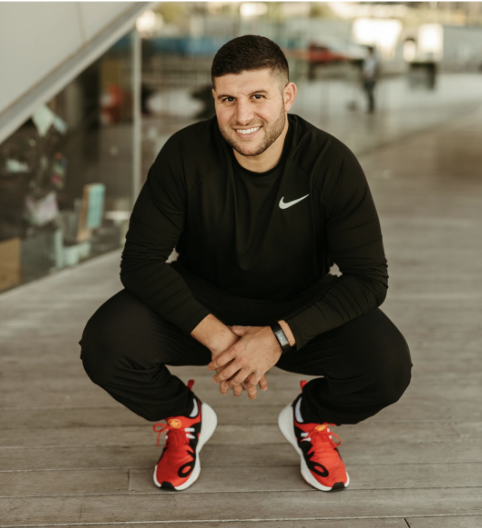FLOATING HEEL EXERCISES: STRENGTHEN YOUR FEET
The lower leg area barely gets any love in traditional strength and conditioning programs.
Why, though?
The feet are the foundation of your athleticism—literally.
Consider these items below, which most people would deem as skills in athleticism:
-
Run
-
Sprint
-
Backpedal
-
Side shuffle
-
Jump
-
Land
-
Pivot
-
Change of direction (cut, turn, etc.)
The list goes on and on, but you get the point.
Our feet are the drivers of these movements, which means that to be athletic translates to a necessity toward keeping this area healthy and strong if you wish to remain durable in your chosen sport.
In addition to directly loading the muscles, tendons and ligaments in the lower leg (i.e., calf muscles, Achilles tendon, etc.) with strength training strategies, it’s important to also challenge dynamic stability with key players in the bottom of your feet: plantar fascia (arch of the foot), intrinsic muscles (little muscles under feet) and the big toe.
Preserving the strength and health of your big toe is crucial for success. The plantar fascia and intrinsic muscles ultimately have a unique relationship with both the big toe and the heel, since they can be found in the middle area of the foot. Suffice to say that these key players need more attention in training.
Enter:he ‘floating heel’ position.
This literally means that the heel of the working leg is “floating” in air and unsupported, while the big toe and upper portion of the foot closest to the toes are supported on an elevated surface such as a 4-inch plyo box or a 45-pound bumper plate.
The implementation of the floating heel position in lower body training is a surefire way to address strengthening all key players (plantar fascia, intrinsic muscles and the big toe) at once by being in a constant state of dynamic stability. Funny thing is that the floating heel position reminds me of the Jumpsoles Training Shoes from the 90’s from a concept standpoint.
Either way, I strongly recommend adding in some variation of the floating heel position to your training program. It can be added into a variety of lower body exercises, but here are a few sample exercises below to get started.
Sample Exercises:
1. DB Floating Heel FFE Split Squat
2. DB Floating Heel FFE Reverse Lunge
3. DB Floating Heel FFE Reverse Lunge w/ Knee Drive
4. Floating Heel FFE Reverse Lunge w/ Push-Off
*Side note: “FFE” in all of the exercise names above is just a nice way to consolidate “Front Foot Elevated”.
Looking for more ways to stay strong and healthy with minimal equipment in the comfort of your own home? Check out our online suite of DIY Workout Guides. The best part is that 10% of sales go to supporting those on the front line of the COVID-19 fight at the CDC Foundation.
ABOUT THE AUTHOR

Matthew Ibrahim is the Co-Owner, Director of Strength & Conditioning and Internship Coordinator at TD Athletes Edge in Salem, MA. Throughout his career, Matthew has been an invited guest speaker nationally in over 10 U.S. states, which was highlighted by his presentations at Google Headquarters, Stanford University, Equinox, Lululemon and Mike Boyle Strength & Conditioning, in addition to guest speaking internationally in Milan, Italy. He has also been an invited guest speaker by the National Strength and Conditioning Association (NSCA) at the regional conference level and at the state clinic level. His professional work has been featured in some of the world’s largest publications, such as Men's Health, Men’s Fitness and STACK Media. Currently, he is a PhD student at Rocky Mountain University of Health Professions in the Human and Sport Performance program. Matthew also serves as an Adjunct Professor of Exercise Science at Endicott College and an Adjunct Professor of Exercise Science at Maryville University. Connect with him on Instagram for training, performance and professional development content: @matthewibrahim_
Like what you read?
Sign up now to get the latest tips and advice
ABOUT THE AUTHOR

Matthew Ibrahim is the Co-Owner, Director of Strength & Conditioning and Internship Coordinator at TD Athletes Edge in Salem, MA. Throughout his career, Matthew has been an invited guest speaker nationally in over 10 U.S. states, which was highlighted by his presentations at Google Headquarters, Stanford University, Equinox, Lululemon and Mike Boyle Strength & Conditioning, in addition to guest speaking internationally in Milan, Italy. He has also been an invited guest speaker by the National Strength and Conditioning Association (NSCA) at the regional conference level and at the state clinic level. His professional work has been featured in some of the world’s largest publications, such as Men's Health, Men’s Fitness and STACK Media. Currently, he is a PhD student at Rocky Mountain University of Health Professions in the Human and Sport Performance program. Matthew also serves as an Adjunct Professor of Exercise Science at Endicott College and an Adjunct Professor of Exercise Science at Maryville University.
